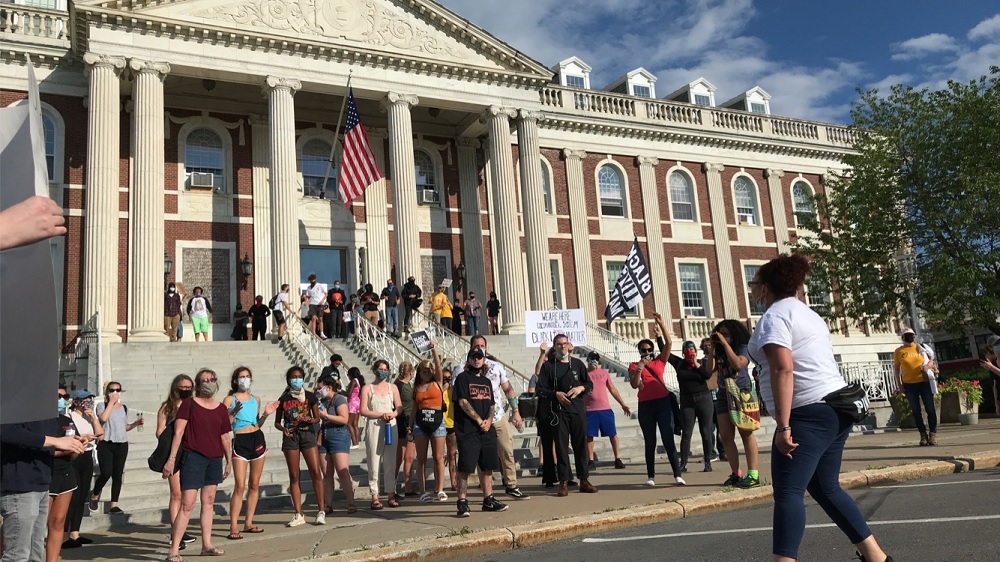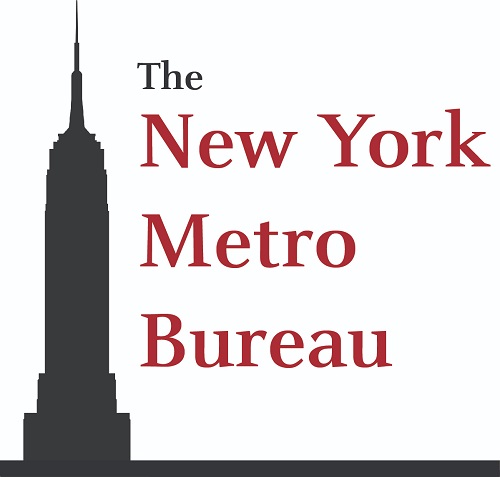
Gabe Stern
Protesters occupied the streets surrounding Schenectady City Hall for over nine hours Monday and early Tuesday morning.
SCHENECTADY, N.Y. — By 9:10 p.m. the only sound audible between protesters’ chants was the distant buzz of two drones high above City Hall on Monday. One belonged to the Schenectady Police Department (SPD), which monitored over 100 protesters who had locked arms at the intersection of Clinton and Liberty streets. The other belonged to a local photographer who had joined the protest, and monitored the police presence in the surrounding blocks.
As Monday night turned to Tuesday morning, the crowd, which had occupied the City Hall area and the surrounding streets for nine hours, prepared for police to come after them. Some wore vests that could stop rubber bullets, others long pants to protect against tear gas. Organizers from the group All of Us said they would end their civil disobedience if Mayor Gary McCarthy immediately agreed to one of their 13 demands: abolition of chokeholds, strangleholds and hogties for all law enforcement and correction officers inside jails and prisons.
 Nearly a month after New York City’s chokehold ban was passed, protesters are pressuring Schenectady city officials to take more aggressive action to ban chokeholds, among 12 other demands that would shape how law enforcement here operates. Schenectady banned knee-to-neck chokeholds in mid-June, shortly after the state passed the Eric Garner Chokehold Act. The statewide ban applies to chokeholds that cause serious injury or death.
Nearly a month after New York City’s chokehold ban was passed, protesters are pressuring Schenectady city officials to take more aggressive action to ban chokeholds, among 12 other demands that would shape how law enforcement here operates. Schenectady banned knee-to-neck chokeholds in mid-June, shortly after the state passed the Eric Garner Chokehold Act. The statewide ban applies to chokeholds that cause serious injury or death.
Monday marked a week since a video made international headlines; Schenectady Police Officer Brian Palmer placed his knee on Schenectady resident Yugeshwar Gaindarpersaud’s neck area. The video, filmed by Jaindra Gaindarpersaud, Yugeshwar’s father, and Palmer’s body camera footage paint a picture of both the encounter and what led to it.
The video shows Palmer holding down Gaindarpersaud in the Guyanese man’s backyard and punching him. His father filmed from the house. “You got your foot on his head!” the father shouted. Gaindarpersaud was suspected of slashing his neighbor’s tires. “Get back inside now,” the officer yelled.
Palmer is currently on desk duty as an investigation into the arrest by the Schenectady Police Department Office of Professional Standards and the Schenectady County District Attorney’s office continues.
The video ignited already tense relations between protesters pushing their demands and city officials.
“It wasn’t just a chokehold, it was a carotid hold. That involves a knee hold. So the argument is splitting hairs in the sense that chokeholds is the stopping of breathing, but we’re also seeing a stop of blood flow to your brain,” said Odo Butler, Schenectady’s NAACP president.
‘Splitting hairs’
The outcome of the investigation will be the first high-profile case in the city involving a potential knee-to-neck chokehold. Under the Eric Garner Chokehold Act, officers can be charged with a class C felony if a chokehold causes serious damage or death, unless it was in self-defense. Gaindarpersaud said Palmer’s knee was on his neck, while Clifford said it was on his head.
Mayor McCarthy, Police Chief Eric Clifford and Public Safety Commissioner Michael Eidens banned the use of knee-to-head holds on Wednesday, one of five preliminary reforms enacted after a meeting with members of the NAACP and the Civilian Police Review Board. McCarthy did not respond to a request for comment.
New York City’s law makes illegal any restraint that restricts airflow or blood by compressing someone’s windpipe or neck or putting pressure on the back or chest. This qualifies as a class A misdemeanor unless the officer is acting in self-defense.
At the Wednesday meeting, Chief Clifford stood at the front of a conference room at SPD headquarters as over a half dozen videos of the arrest played — footage filmed by Jaindra Gaindarpersaud, Palmer’s body-camera footage and additional footage from other officers who arrived later on the scene, according to an attendee of the meeting.
Whether Palmer’s knee was on Gaindarpersaud’s neck or head was “splitting hairs,” Clifford said, according to the attendee.
Protesters chanted for Palmer’s immediate removal from the police force on Monday.
While a protest Friday was organized in part as a response to Gaindarpersaud’s arrest, organizers also demanded that McCarthy and Clifford take quicker action on their 13 demands. Organizers Jamaica Miles, 45, and Mikayla Foster, 21, said after a Sunday morning Zoom call with McCarthy and Clifford that they felt disrespected.
Rumors swirled at the protest that SPD would use tear gas or call in backup. Just after midnight, Clifford tweeted he had “shown this community my willingness” to discuss police reforms and remained patient as All of Us protested.
“That all ends tonight,” he tweeted. “No more disorder in the city.”
Earlier he had said that blocking intersections would not be tolerated. Protesters had signed forms that had emergency contact information in case they were arrested.
“We are risking arrest, we are not resisting arrest,” Miles shouted through a megaphone Monday as protesters linked arms at the intersection. Some protesters who did not want to risk arrest stood on the sidewalk, ready to film any interactions between police and protesters.
Earlier in the day, around 8:05 p.m., vehicles with officers in riot gear arrived briefly on scene after protesters outside City Hall and police officers inside struggled to get control of the main door. When officers threatened arrest if anybody blocked them from leaving, protesters locked arms. Nobody left the SWAT vehicles and protesters moved to the intersection, where they would stay for nearly five more hours. The police presence was not visible, except for the department’s drone.
Just after 12:30 a.m, organizers discovered that police would not stop them from blocking the street.
“[Clifford] said ‘we can’t do this, yet still here we are,” Miles told protesters, and they dispersed just before 1 a.m.































